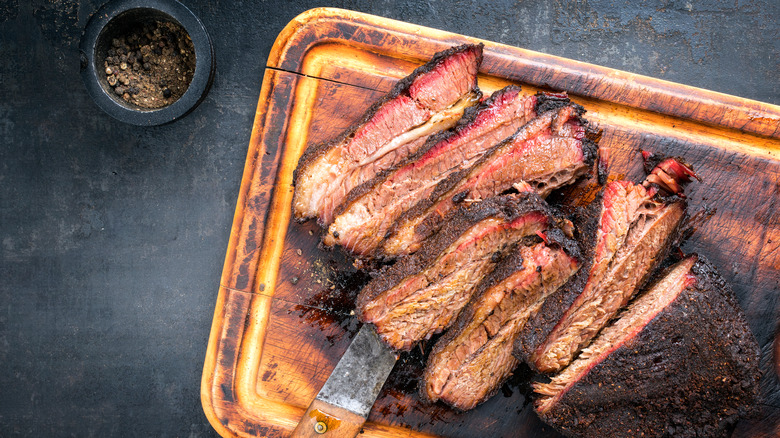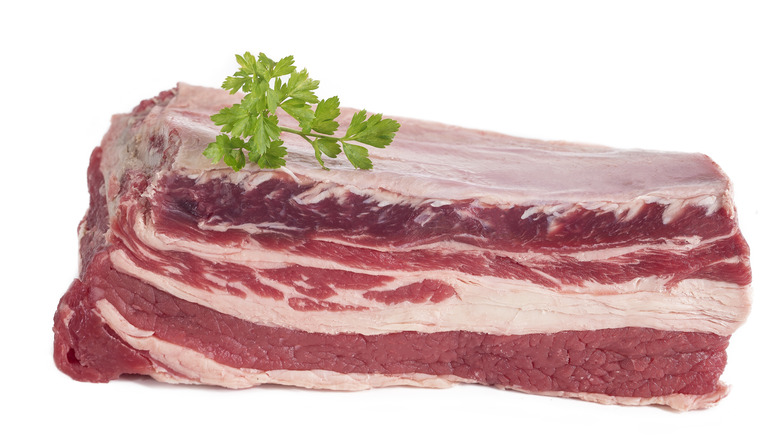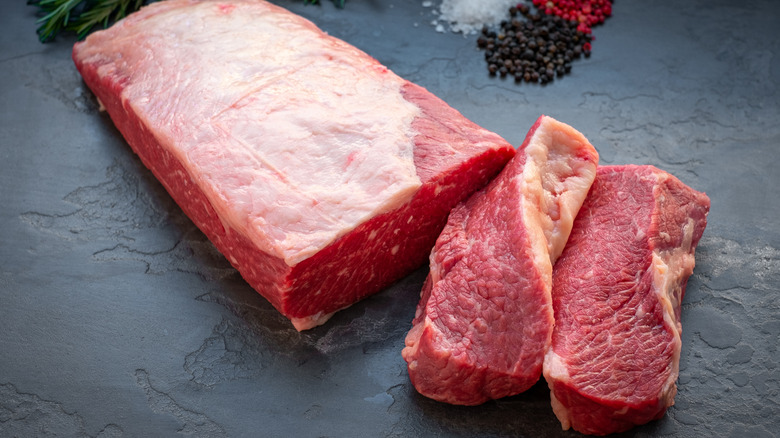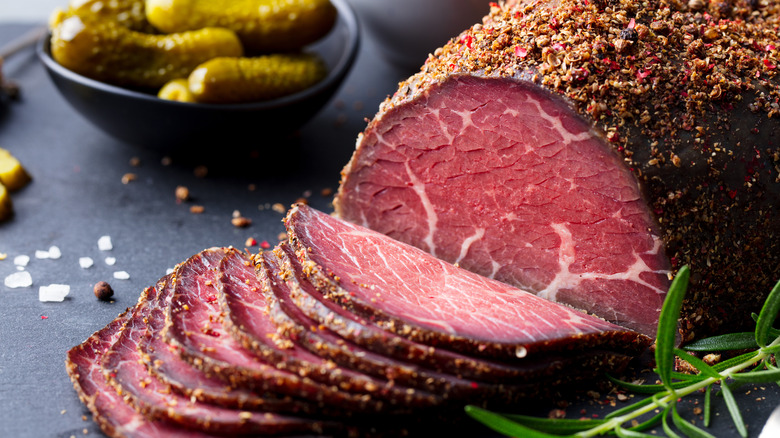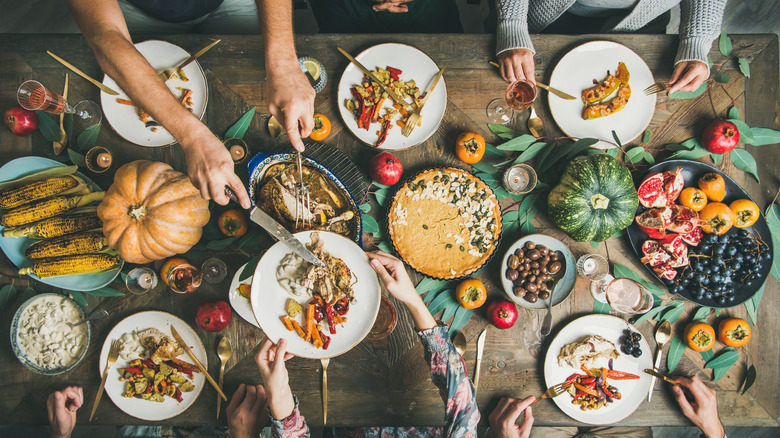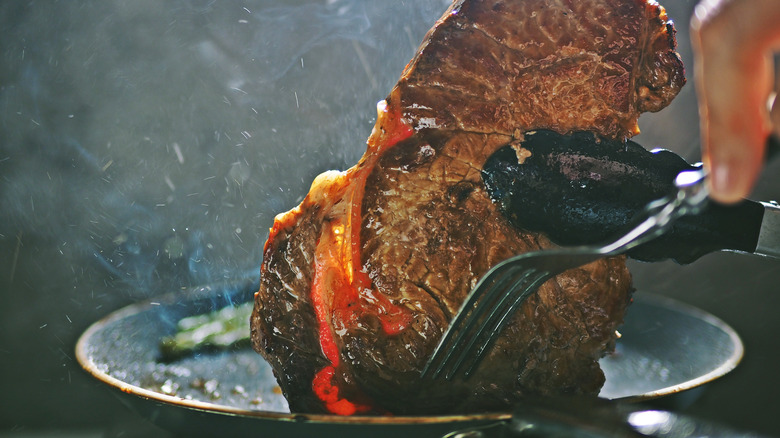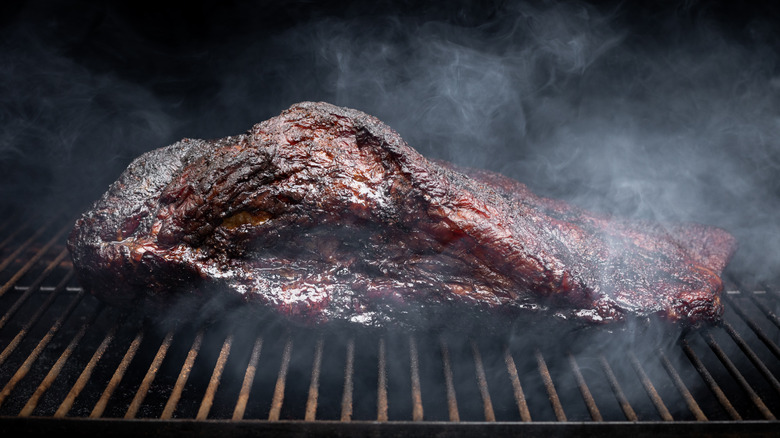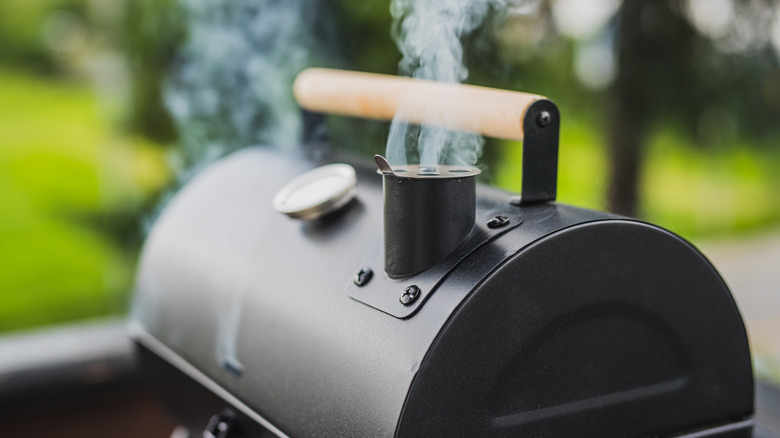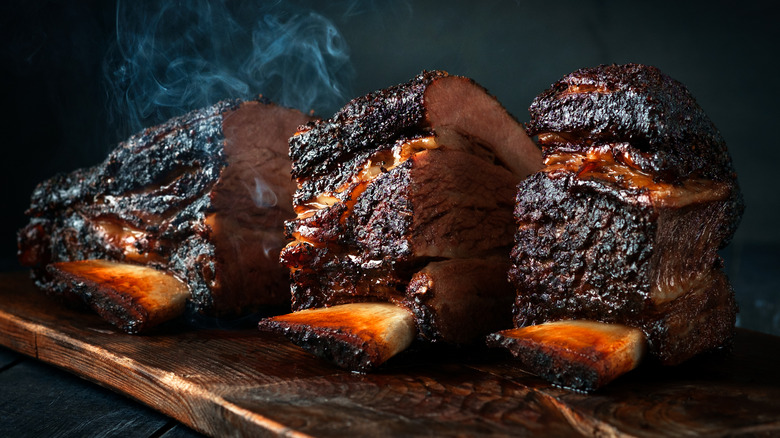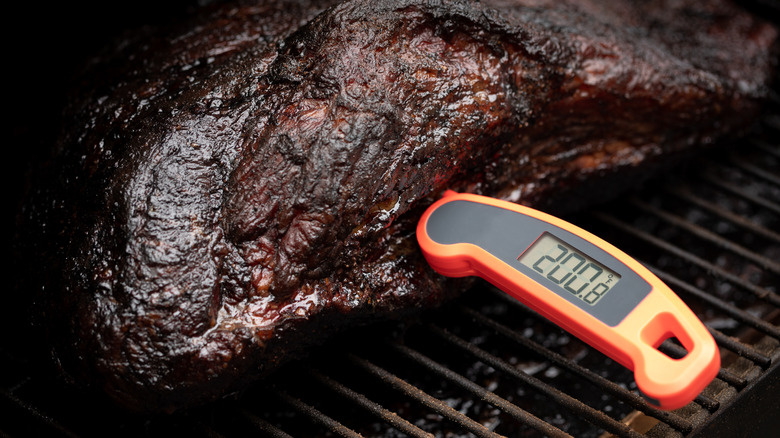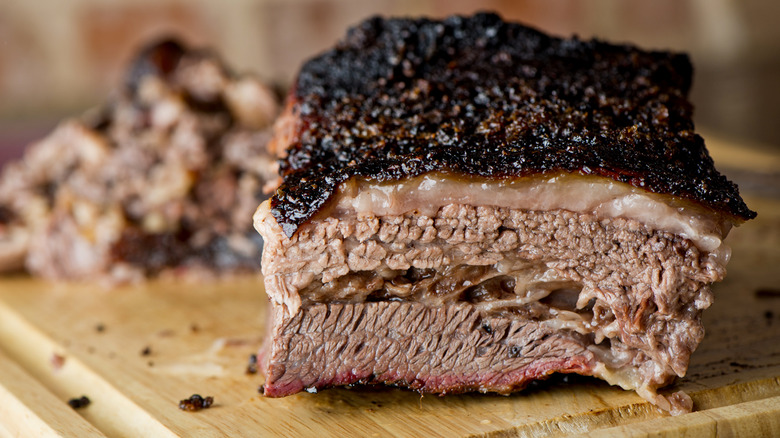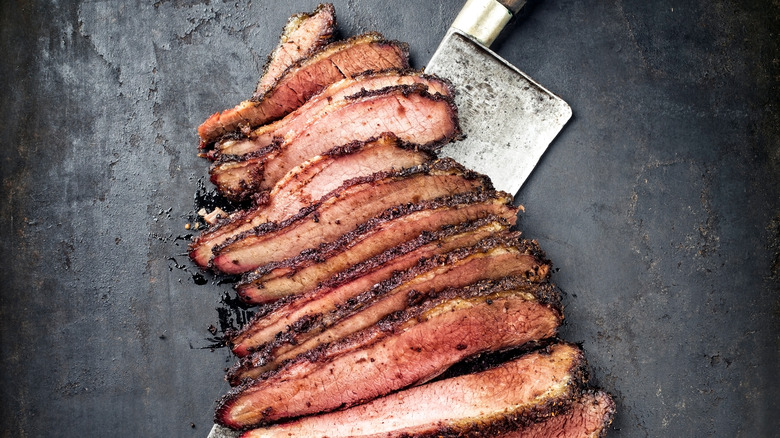Mistakes Everyone Makes When Cooking Brisket
There's nothing better than a juicy piece of brisket. It's delicious no matter how you cook it: cured into pastrami or corned beef, smoked for Texas barbecue, or oven-roasted for a Jewish holiday. Unfortunately, there's a reason the saying "brisket, don't risk it" exists, and we've all had a less-than-perfect brisket that turned out drier and chewier than we hoped. This huge cut of meat takes twice as long to cook as other braising meats, and it can lose its moisture easily if it's not prepared correctly. Considering that a whole brisket can run upwards of $50, it's not exactly an inexpensive mistake.
Luckily, it's completely possible to pull off a mouth-watering, fall-apart-tender brisket. You don't need to be a certified pitmaster to do it, either. It's all about paying attention to the details and avoiding many of these common mistakes everyone makes when cooking brisket. Armed with this knowledge, you'll be ready to cook brisket for anyone — maybe even a holiday meal!
Not picking a brisket with good marbling
Brisket comes from the breastbone area of the cow, and it's basically the animal's pectoral muscles. This well-worked muscle is tough and full of muscle fibers, so it can't be cooked like a steak. Instead, it requires low-and-slow cooking techniques, like braising or smoking. These low temperatures give the fibers an opportunity to break down, becoming juicy and tender, but they need a little help to stay that way. That's where marbling comes into play.
Marbling — or the white streaks of fat found in between the muscles — is a critical element to creating a juicy brisket. Many Texas BBQ joints use Prime grade beef or Certified Angus Beef (CAB) because of their high levels of marbling and fat. During the long cooking process, that fat slowly renders out and keeps the meat juicy and moist, preventing it from drying out. If you pick up a Select grade brisket, it won't hold up over the long cooking process and will taste a little dry in the end.
Choosing the wrong cut of brisket
Although brisket is the name of one of the eight primal cuts of beef, it is sold in several different ways. While all of the cuts of brisket are delicious, some are better suited for certain tasks than others. If you buy an untrimmed or "packer" brisket, you'll receive the whole brisket. But you can also purchase the two individual muscles that make up the brisket: the flat and the point.
The first cut of brisket is called the flat cut, or the leaner portion of the brisket. Although this piece still has a large fat cap on the top, it contains significantly less marbling within the meat. The second cut, or the point, is connected to the flat cut by a very thick piece of fat known as the deckle. Many people say the point is more flavorful, but it really just contains more fat than the flat cut.
The right cut of brisket really depends on what you intend to do with it. If you're curing corned beef or pastrami, the flat cut is better because it's easier to slice. The point, on the other hand, is juicier and richer, so it's best for smoked brisket or braised stew dishes.
Buying a corned beef instead of a fresh brisket
If you're hoping to wow your guests with a smoked brisket at your next backyard barbecue, make sure you don't accidentally come home with corned beef. They look very similar, but they're not the same thing. Corned beef is made by taking a cut of brisket (usually the flat cut) and soaking it in a heavily salted brine to infuse tenderness into the meat. That brine also adds a salty, spicy, and sour flavor to the beef. While you can smoke corned beef, and it will definitely taste delicious, it creates a product that's more similar to pastrami than barbecue.
Instead, be sure to check the label on the package before you leave the grocery store. If you're unsure, you can ask the butcher for his or her advice. But any added ingredients like salt, sodium nitrite, or flavorings are a sure give-away that you're probably buying a ready-to-cook corned beef.
Not buying enough brisket to feed a crowd
It's difficult to gauge how much food you need when cooking for a crowd, and brisket doesn't make it easy. Briskets — especially packer briskets that contain the point — contain a heavy fat cap. That fat breaks down to keep the brisket moist as it cooks, but it's not edible. All things considered, between the inedible fat and the water loss the brisket experiences as it cooks, a brisket will yield only 65 to 76 percent of its original weight. That means a raw, five-pound brisket turns into an edible portion of 3.25 to 3.8 pounds.
Don't worry; you don't have to do a bunch of culinary math in your head while you're standing at the grocery butcher counter. The Kitchn recommends purchasing a half-pound of raw brisket per person as a good rule of thumb. So that five-pound brisket will feed about ten people. It's never a bad idea to add an extra pound or two, though, just in case your guests are super hungry. And if you end up with too much, you can always slice and freeze the leftovers.
Skipping the first step (searing the brisket)
The first step in any braised dish is usually searing or browning the meat to add flavor and color to the dish. Brisket is no exception. The only problem here is that the brisket is a gigantic hunk of meat. Instead of flipping a one-pound steak or turning small, bite-sized pieces, you're being asked to pick up a roast that could be over five pounds. It sounds intimidating, and worth skipping, but trust us — it's definitely worth doing.
Bon Appétit suggests browning the brisket for at least ten minutes per side. The amount of time adds a beautiful browned character to the meat, which enhances the flavor later. Getting each side fully caramelized takes time, so set aside these twenty minutes to start your brisket off right. If you have trouble flipping it with a single set of tongs, try grabbing a second set of tongs to help. You can also use a rigid spatula or stirring spoon to hold one end of the brisket up while you flip the other.
Not cooking the brisket long enough
Brisket is not a last-minute dinner plan, and it's definitely not an easy weeknight dinner. If you're smoking it on a 225 degree Fahrenheit smoker, it can take as much as an hour and fifteen minutes per pound. Even if we increase the heat and cook it in a 275-degree oven, you'll still need to plan for an hour per pound. We're looking at five to six hours total for a five-pound brisket, so you'll want to plan ahead.
The good news is that brisket tastes better the next day, and it gets more tender as it sits. After your brisket is finished cooking, let it cool down to room temperature. Then, place the brisket (and any sauces it cooked in) in a glass casserole dish and cover it tightly with plastic wrap. The next day, slice the meat and put it back in the casserole dish. Cover it with foil and bake it in a 350-degree oven for about an hour, until it's heated through.
Cooking brisket too hot
If you're running short on time, you might be tempted to crank up the heat of the grill, smoker, or oven. But blasting the brisket is a sure-fire way to end up with a tough, chewy hunk of meat. As we mentioned earlier, brisket is a tough muscle. It gets a lot of use during the cow's life, so this very strong muscle is filled with a lot of connective tissue. The good news is those long muscle fibers will break down into something called collagen, which softens and melts when cooked correctly. The bad news is that process won't happen quickly.
According to "Steve Raichlen's Barbecue Bible," you need low temperatures (215 to 225 degrees Fahrenheit) and long cooking times to melt that collagen, along with the other tough connective tissue in the brisket. Some pitmasters increase their temps to 285 to 325 degrees, but you can't go much hotter than that. Higher temperatures will cause the meat to seize up and get tough.
Letting all of the brisket's moisture escape
If we had to pick a single secret for cooking a perfect brisket, it would be this one. The grill or a smoker is the ideal way to infuse smoky flavor into your brisket, but cooking brisket uncovered is a great way to let all the moisture escape. Luckily, you can have your cake and eat it too — a smoky brisket that's also juicy and moist — if you follow the rules.
Brisket is a very large cut of meat and experiences something called the plateau or the stall. When it reaches the 160 degrees Fahrenheit mark, the meat stops increasing in temperature. Greg Blonder, Ph.D., explains that the meat is basically sweating, releasing enough moisture that it keeps the meat cool while it cooks. This moment is the perfect opportunity to take your exposed brisket off the smoker and wrap it in aluminum foil or butcher paper. That allows the meat to absorb smoke for the first few hours of its cook time while keeping the moisture in for the remaining hours.
The same principle applies to oven-roasted brisket. That evaporative cooling still happens at 160 degrees, so you'll want to keep the brisket covered for the entire cook time to keep the steam inside the pot.
Cooking brisket without a thermometer
The poke test — checking the doneness of meat by comparing its feel to your hand — might work okay for smaller items like steaks, but it's definitely not going to work for a brisket. For starters, brisket isn't cooked to the same temperatures as other cuts of beef. The United States Department of Agriculture (USDA) says that fresh beef like steaks are safe to eat at 145 degrees Fahrenheit, but brisket would be inedible at these temps. It would be chewy, undercooked, and generally unpleasant.
Instead, large, tough cuts like brisket, pork shoulder, and pot roast need to be cooked to higher temperatures. These meats have a lot of connective tissue and it needs to break down before they're edible. When the temperature hits 190 degrees, the fibers begin to break down and become tender, but the magic really happens between 200 and 210 degrees. It's impossible to know what the temperature is inside the brisket without a thermometer, so you'll want to pick up an instant-read or probe thermometer if you don't already own one.
Slicing brisket before resting it
We know, you just spent hours cooking brisket and you don't want to wait any longer. Can't you just slice it and be done with it? Yes, you absolutely can, but it would be a mistake. According to ThermoBlog, moisture moves out of the muscle fibers and towards the surface of the meat as it cooks. When you're finished cooking, any moisture that didn't evaporate is still there, but it's still hanging around the surface. If you sliced the brisket without resting it, all that moisture (aka, juicy flavor) would seep out onto the cutting board. Give it time, though, and the moisture will redistribute throughout the meat.
Unlike smaller pieces of meat, a 15-minute rest isn't enough here. Brisket is a large cut of meat, so it requires more time to redistribute the juices. A recipe adapted from Franklin Barbecue — a famous BBQ restaurant in Austin, Texas — suggests resting brisket for an hour. NPR's The Salt makes a similar suggestion, recommending that cooked brisket rest in an empty cooler, swaddled in towels, for a couple of hours. So, you're going to have to remain patient for an extra hour or two.
Forgetting to slice brisket against the grain
If you did everything right — bought the right brisket, seared it and cooked it at low temperatures for hours, checked the temperature, and let it rest — you could still mess up a perfect brisket when slicing it. It's all about something called the grain, and the correct way to slice a brisket is against the grain.
Brisket is full of muscle fibers, which run parallel to each other. If you cut with the fibers (or, with the grain), each slice will contain long strands of fiber. That will make the meat seem chewy and tough, even if it's cooked perfectly. Instead, if you cut against the fibers, making perpendicular slices, the slices will contain shortened fibers. These fibers are easier to chew, making the meat more tender.
It's sometimes hard to find the grain in tender steaks, but it's pretty obvious on a tough cut like brisket. Take a close look at the cooked meat and look for long lines. When you identify them, position your knife in a "T" with the fibers to slice against the grain.
